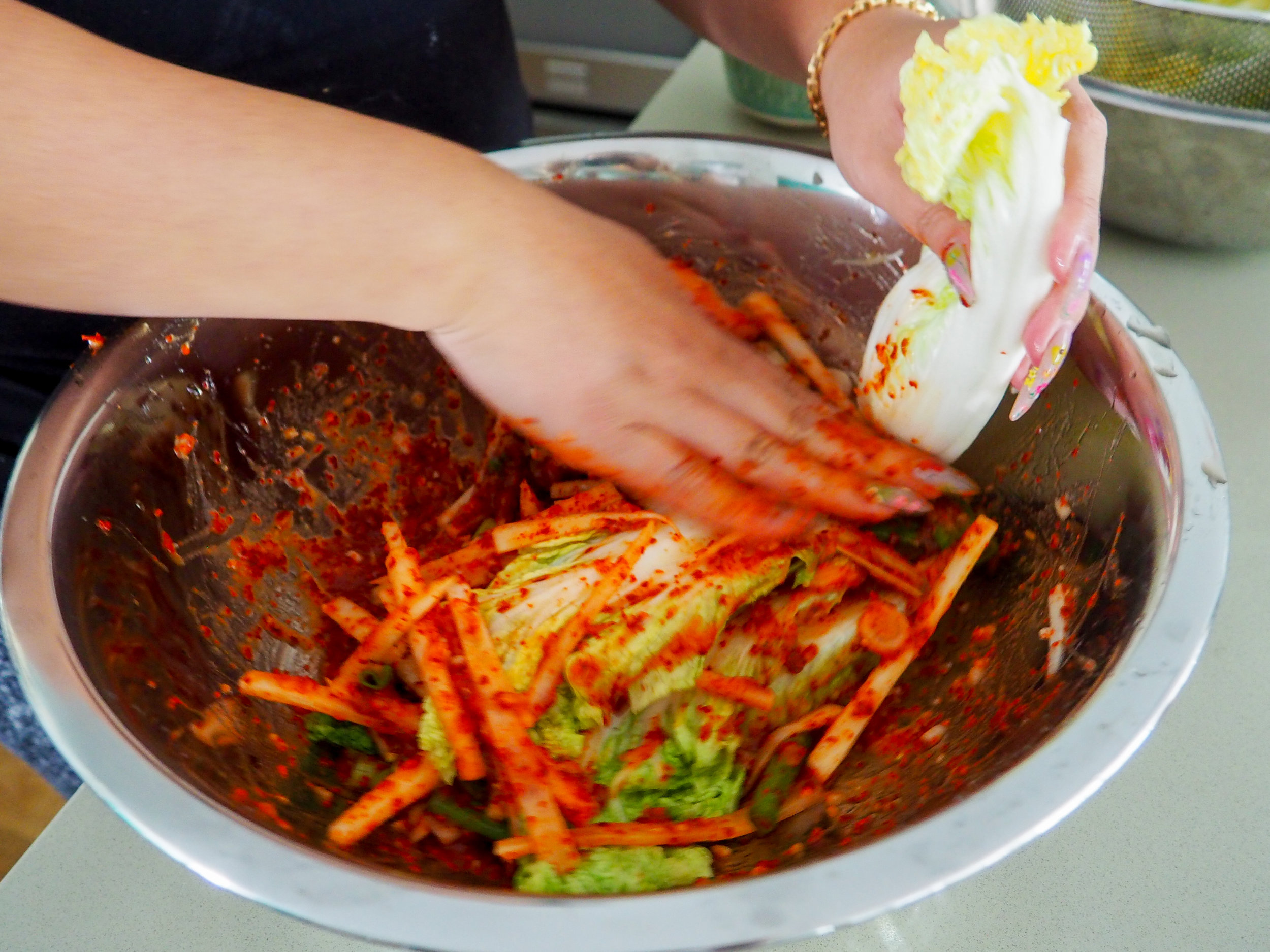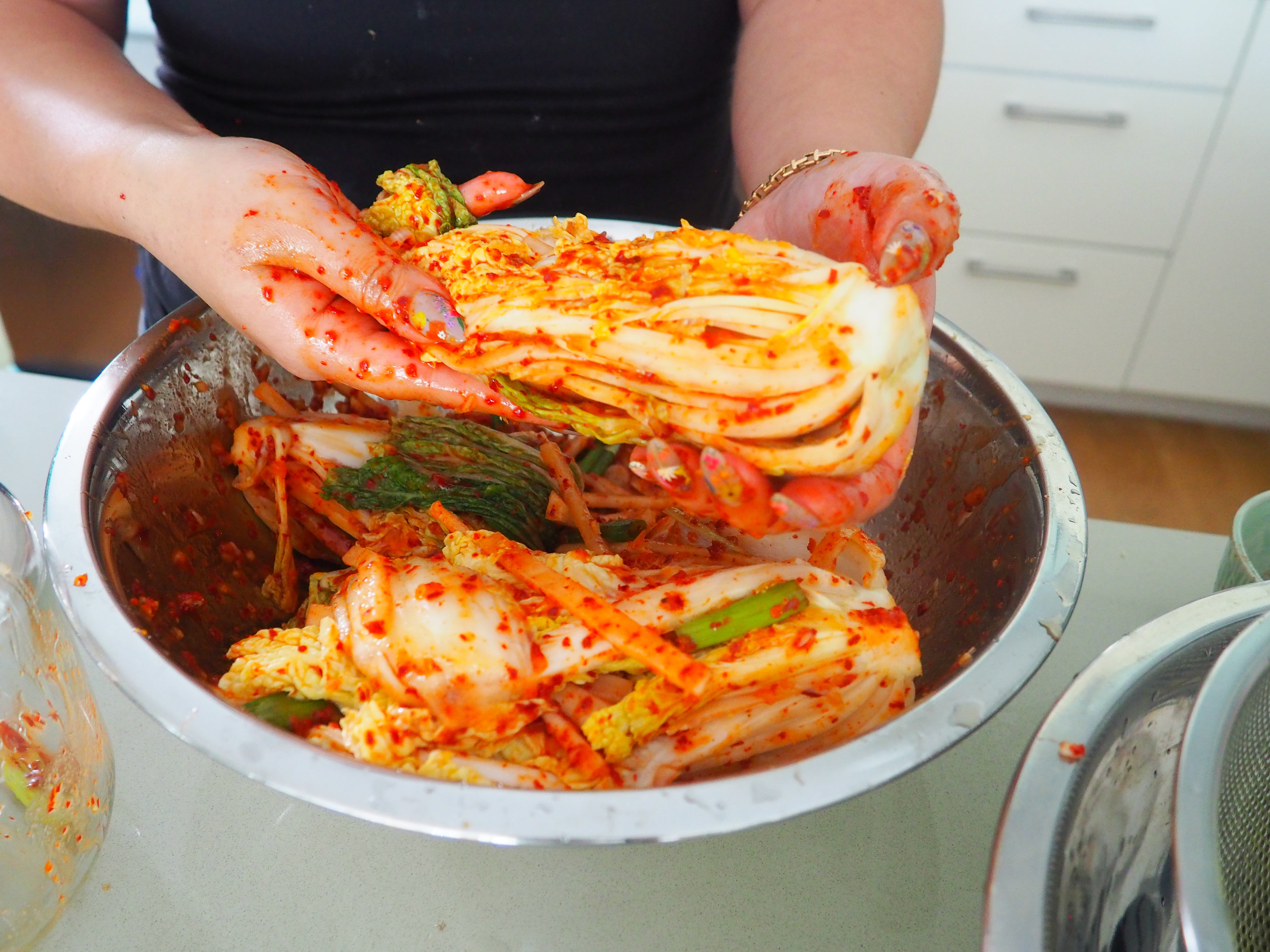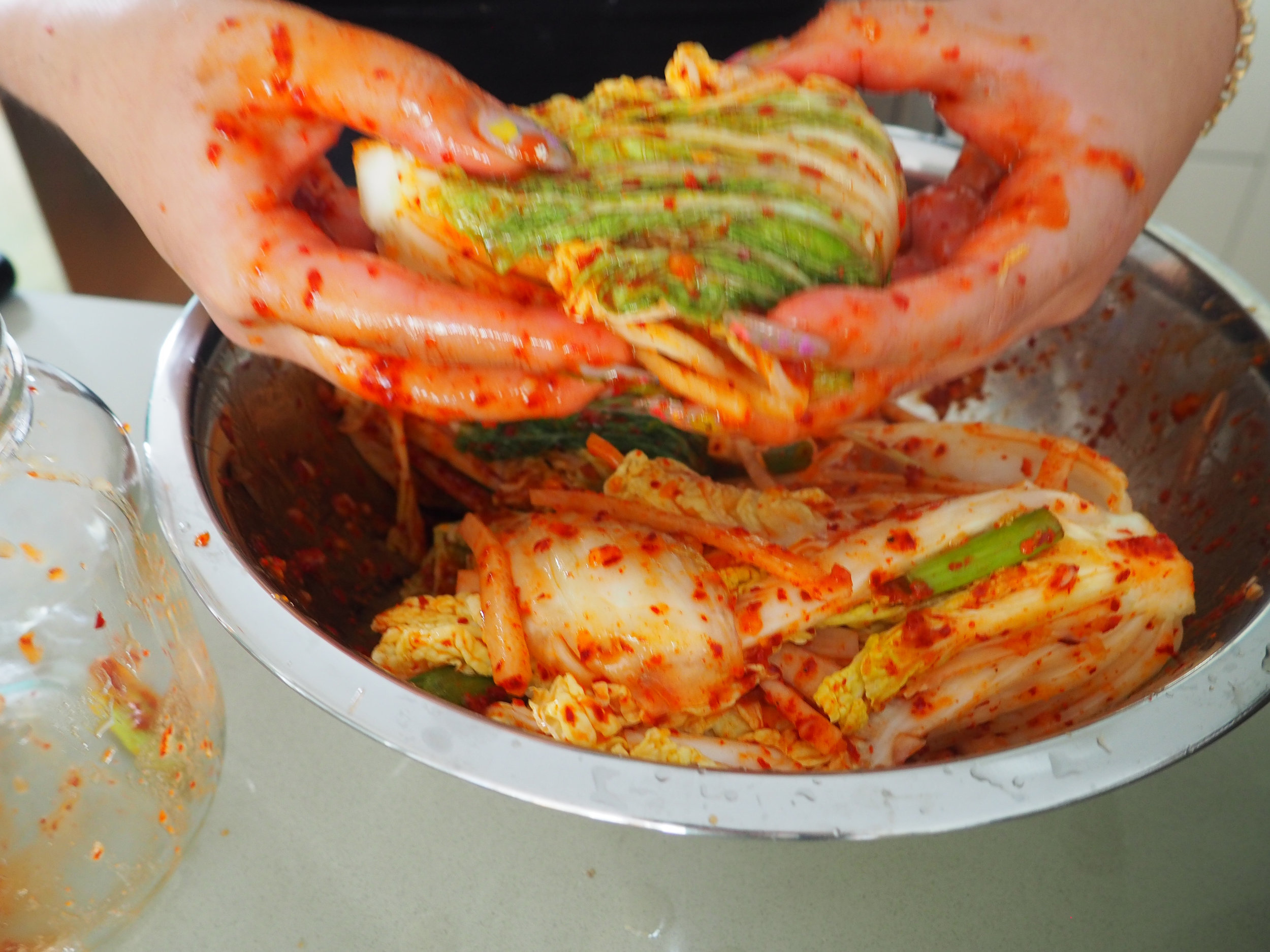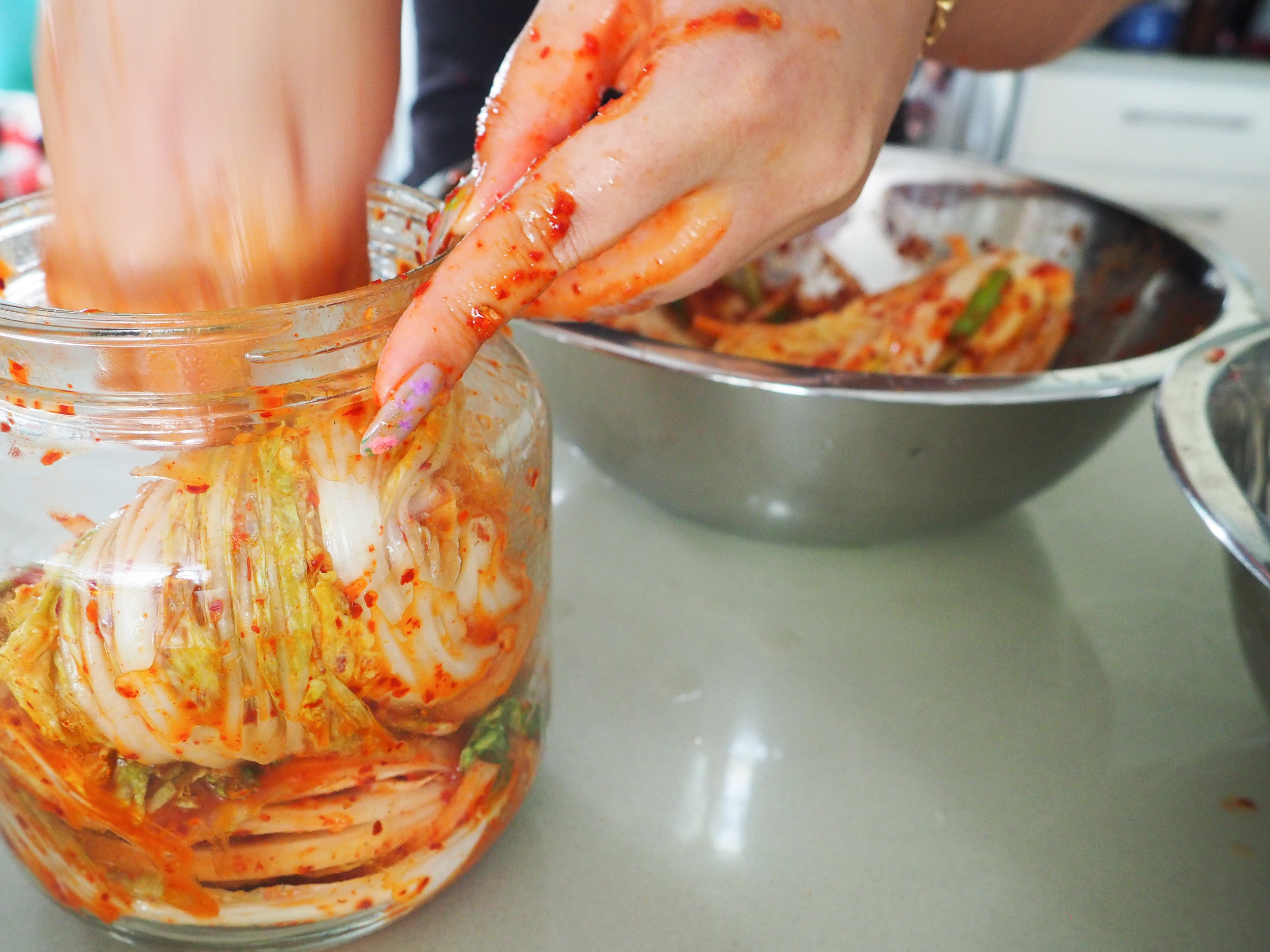Making kimchi with my mother is one of my fondest food memories. I remember squatting on our kitchen floor and assisting my mom as she prepared this complex dish. She would meticulously chop and assemble all of the ingredients and narrate what she was doing. After what seemed like hours of work, my mom would pop a tiny cabbage leaf dressed in the kimchi paste into my mouth and ask me what I thought about the flavors. I loved the fresh and briny cabbage, the complex kimchi paste, and being hand-fed by my mother. Most of all, I loved that mother bestowed a significant responsibility on me—taste testing. I felt so valued, and it was not lost on me that my opinion would impact the outcome of the flavors of the kimchi we made.
As I get older, I wonder about what memories kimchi holds for my mother. I wonder what she must have felt immigrating to America when she was younger. How difficult it must be to be separated from her mother and five sisters. As I prepare for an international move, I empathize with the comfort she found in being able to make food that so deeply reminded her of home because making kimchi reminds me of my childhood home — #ElPasoStrong.
I cherish making my mother's kimchi and am so proud to share it with my loved ones. This recipe holds a significant place in my heart because it connects me to my family's past, to Korea. Kimchi brings my heritage into my present and into my family's future. I am posting this recipe to honor my mother, my grandmother, my aunties, and all the strong Korean women out there making kimchi for their loved ones.
Recipe Type: Special Occasion & Labor of Love
Time: 6+ hours
Servings: Makes ½ a gallon of kimchi
From Le Kimchi Party Menu
Ingredients
2 heads of Napa cabbage
1 ½ cups kosher salt
2 tablespoons sweet rice flour (it’s also called glutinous rice four)
1 ½ teaspoons fermented salted shrimp
8 oz of Korean Radish (Mu) or Daikon
1/2 teaspoon peeled fresh ginger
1/2 onion
4 garlic cloves
4 scallions
3-6 tablespoons fish sauce (I use the Three Crabs brand)
¼ - ½ cup of Gochugaru (Korean hot pepper flakes - kimchi grind)
2 teaspoon sugar or 1/2 of an Asian pear peeled and cored
Toasted sesame seeds (for garnish)
Equipment
Large mixing bowl
Colander
Food-grade disposable gloves
Half gallon fermentation vessel (I like glass jars or these metal kimchi containers)
Instructions
Phase 1: Brine the cabbage
Time: (4 hours or overnight)
Salting and brining the cabbage is the crucial first phase of making kimchi. This process draws water from the cabbage and prepares it for lacto-fermentation. You can brine the cabbage in the morning and make kimchi in the afternoon, or you can brine overnight and make kimchi the next morning.
How to brine the cabbage for kimchi
Dissolve ¾ cup of kosher salt in 8 cups of water in the largest mixing bowl that you own to make the brine.
Cut the Napa cabbage
Make a cut about 4 inches above the bottom of the root/base and cut through the center of the white stalk of the cabbage so that you cut the cabbage lengthwise.
Then, gently grab the two pieces of the base of the cabbage and split the leaves apart.
Then cut a notch into the base of each half of the cabbage. Cut 3 inches above the base of the cabbage in the center. You will split the halves into quarters later.
Dunk each half of cabbage into the brine you prepared to moisten the leaves
Sprinkle the remaining ¾ cup of kosher salt in between each layer of the cabbage leaves. Make sure you add more salt closer to the core/base of the cabbage since those parts are thicker and take longer to brine.
Place the salted cabbage cut side up into the saltwater brine and submerge into the brine. I weigh my cabbage down with a lid or a pot. If you are unable to submerge the cabbage, then make sure to rotate the cabbage 3-4 times during brining. pour the brine on top of the cabbage halves.
Rotate the cabbage (put the cabbage that was on the bottom on the top) and spoon brining liquid onto the cut side up cabbage a couple of times so that . Make sure the cabbage is always cut side up so the salt stays in between each layer of leaves.
Brine the cabbage for at least 4 hours or overnight. The cabbage is ready dress in kimchi paste when the leaves are pliable and floppy.
Phase 2: Prepare the Kimchi Paste
Time: 20 minutes
After the cabbage is brined, rinse the salt off of cabbage thoroughly. I like to rinse my cabbage 3 times. As you rinse, split the cabbage into quarters by pulling on the base where you cut notches into the cabbage.
Drain cabbage in colander set over an empty bowl (to collect water) and set aside.
In a small saucepan, cook the rice paste by whisking 2 tablespoons of sweet rice flour into 1 ½ cups of cold water off heat. After the mixture has been incorporated set the saucepan over medium-high heat until mixture comes to a boil taking care to whisk occasionally. Once boiling, whisk constantly and cook for 1-2 minutes until the mixture thickens into the consistency of sweetened condensed milk. Remove the rice paste from the heat and let cool.
Open the clean fermentation vessel and set near the mixing bowl.
Prepare the following ingredients and place into the largest mixing bowl you own:
8 oz Korean Radish (Mu) peeled and julienned into thin matchsticks (slice into rounds then stack the rounds and slice the rounds into sticks)
2 teaspoons ginger, half an Asian Pear or sugar, ½ onion, and 4 garlic cloves coarsely pureed in a food processor. If you don’t have a food processor, you can grate the onion and pear on the coarse side of a box grater and finely mince the garlic and ginger.
1 ½ teaspoon salted shrimp chopped finely, 4 scallions chopped into ¼ inch pieces, 3 tablespoons of fish sauce ¼ cup of chili flakes, and all of the cooled rice paste
Mix the ingredients in the bowl by hand (optional - put on gloves). This is now the kimchi paste.
Phase 3: Dress the cabbage
Time: 10 minutes
Tear off a small cabbage leaf, and cover it in the kimchi paste. Taste it. Add fish sauce to make the kimchi saltier and add more chili flakes to increase spice levels according to your personal preference. Make sure you season the kimchi paste slightly saltier and spicier than you want the finished product to be, because as the kimchi ferments, it will become less spicy and less salty.
Place each cabbage quarter into the bowl with the kimchi paste and dress each quarter of cabbage by covering each layer of cabbage in kimchi paste (including the radishes and scallions in the paste) by hand. Make sure the cabbage is thoroughly covered in the kimchi paste.
Place each cabbage quarter cut side up into the fermentation vessel. Stack the kimchi quarters on top of each other in the fermentation jar.
After you have stacked all of the cabbage quarters in the jar, press down on the cabbage to remove any extra air from the jar and place any remaining kimchi paste on top of the kimchi. Wipe away excess sauce from the rim, and close the jar.
Notes on Fermentation
Let the kimchi sit out on the counter at room temperature for two days to kickstart the fermentation process. Then store in the fridge. It will continue to ferment in the fridge.
You can enjoy the kimchi as soon as you make it.
Kimchi will keep for a long time (up to a year or more) and the flavor of the kimchi will change as it ages.
How to Serve
Remove a quarter of the cabbage from the fermentation jar. Put the fermentation jar back in the fridge.
Lay the cabbage out on a cutting board, and cut off the core. You can finely mince the core and serve or compost it.
Cut the leaves across the length of the cabbage so that you have bite sized pieces.
Place the kimchi in a shallow bowl and pour some of the kimchi juice over the top and top with some sesame seeds.
Make sure to store kimchi that has been removed from the fermentation jar and cut up separately. You do not want to add kimchi that has been out of the fermentation jar back into the jar.
I like to take the chill off my kimchi and set it out at room temperature for about 30 minutes prior to eating to taste the different nuances in flavors.








